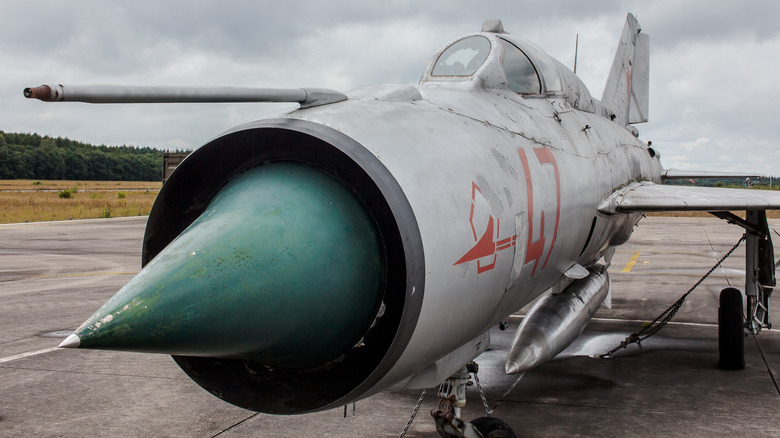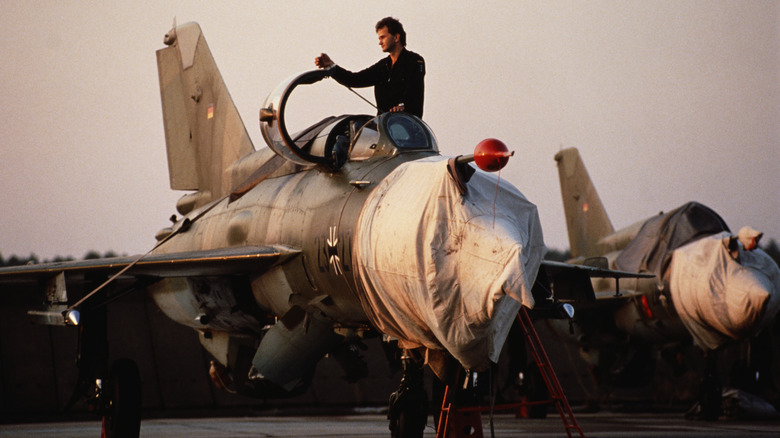Why The MiG-21 'Flying Coffin' Is Still In Use After More Than 60 Years
Aviation technology has come a long way. When Orville and Wilbur Wright completed their first true flight in December 1903, they could scarcely have imagined what the future of flight had in store. The former piloted the craft for all of 12 seconds on that trip. Over a century later, millions of us around the world take long-haul flights every year, sometimes all the way around the world. Often in great comfort, too, with access to an in-flight entertainment system, quality food, magazines to peruse, and everything else we could wish for.
In some cases, the world just hasn't been ready for some of the remarkable advancements that have been made. The iconic original Concorde, for instance, caused a sensation that ultimately fizzled out, and non-supersonic flights have continued to be the norm for commercial flights. This isn't to say that supersonic technology hasn't stood the test of time in other instances, though. The MiG-21 jet continues to be a mainstay despite its age and macabre nickname of "Flying Coffin."
Why the flying coffin?
One compelling aspect of a disinclination to fly, of course, is the fear of a crash. While flying is often touted as one of the safest forms of travel ( "the annual risk of being killed in a plane crash for the average American is about 1 in 11 million," writes the Harvard School of Public Health's David Ropiek for PBS), the MiG-21 seems tragically prone to such disasters, hence its nickname.
The Mikoyan-Gurevich MiG 21PF was developed by the Soviet Union during the Cold War era. From 1960 to 1968, this vintage fighter jet had its gun replaced with a more sophisticated missile system and underwent a series of structural changes intended to increase performance, reliability, and safety.
MiG-21 models saw use around the world, but it has proven rather dangerous. According to CNBC, between 1963 and July 2022, there had been almost 300 crashes and dangerous mishaps involving the jets. They continued to be widely used by the Indian Air Force, however, for lack of a readily-available alternative. Soviet aircraft were outpaced by the likes of the remarkable XB-70 bomber at the time of their introduction, so it's clear that an upgrade is long overdue.
The future of the MiG-21
MiG-21 models have served as a prominent part of the Indian Air Force since 1963. It was more accessible at the time and a rapid response to escalating tensions was needed. Though it has a reputation for the frequent tragic accidents attributed to it, the aircraft remains difficult for the Indian Air Force to replace.
As once-chief of air staff Air Vice Marshal Sunil Nanodkar put it to the Hindustan Times in 2021, the nation had little option. "The induction of multi-role fighters was delayed, only 36 Rafales came instead of the projected requirement of 126 jets, the light combat aircraft (LCA) program is behind schedule, and fighters such as Sukhoi-30 have had serviceability issues," Nanodkar said. The situation, as the retired Air Vice Marshal put it, was that the MiG-21 Bison was the primary craft available in the numbers required, despite ongoing efforts to replace it.
On July 28, 2022, the Indian Air Force's official Twitter account confirmed, two pilots were killed when "an IAF MiG 21 trainer aircraft met with an accident in the western sector during a training sortie." Following this latest tragedy, it appears that the stalwart aircraft's days may finally be numbered. A military source quoted by The Times of India has stated that the country's MiG 21 fleet as a whole will be retired by 2025.


